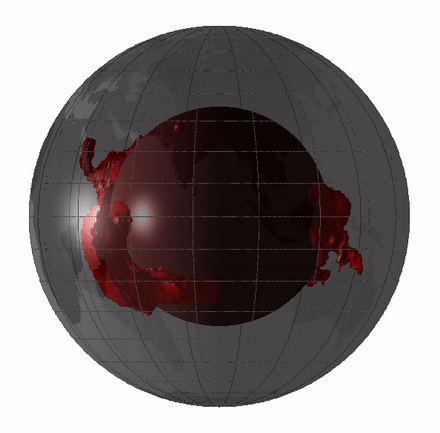Strange things are occurring beneath Earth’s surface (as ever). Some 2,896 kilometers (1,800 miles) below the planet’s crust, about halfway to the center of the Earth, two giant blobs can be found on roughly opposite sides of the planet. One is situated beneath Africa, while the other lives under the middle of the Pacific Ocean.
The blobs are technically known as thermochemical piles, or large low shear velocity provinces (LLSVPs), continent-sized regions that are physically distinct from the surrounding Earth’s mantle.
Scans of Earth’s interior clearly suggest the blobs are there, but little else is known about the bizarre structures – after all, it isn’t easy to send a scientist, or even a probe, into Earth’s mantle. However, the mysterious phenomenon clearly needs prying into.
One particularly fascinating theory is that they are the remnants from Earth’s formation, 4.5 billion years ago. If that’s true, they could provide some huge insights into the inner workings of Earth, as well as its complex history.
“While the origin and composition of the blobs are yet unknown. We suspect they hold important clues as to how the Earth was formed and how it works today.” Edward Garnero, an expert on planetary interiors and professor at Arizona State University (ASU), said in a statement in 2016.

Animation showing both LLSVPs created using seismic tomography.
Garnero, together with other geologists at ASU, published a review about the giant mantle globs in 2016 using bucketloads of seismic, geochemical, and mineral physics data.
While they did not explain the origin and composition of the “anomalous provinces”, the article did highlight how they might play a role in the all-powerful geological forces we see on Earth’s surface, like volcanic eruptions, the shifting of tectonic plates, and earthquakes.
Many volcanoes are found along the edges of tectonic plates, rising from the depths of Earth as the boundaries crumble into each other, but not all. Some are formed by mantle plumes, a column of hot rock that rises from deep within Earth’s mantle, a bit like a blob of wax floating to the top of a lava lamp. When the plume reaches Earth’s rigid outer shell, the magma can pool and eventually break through the surface, forming a volcano.
It’s possible, albeit by no means certain, that the giant blobs in the mantle below Africa and the Pacific could breach the crust and create massive supervolcanoes that have the capability to erupt for millions of years.
That chilling thought remains speculative, as we know so little about the blobs. Yet, it’s not only their ominous potential that should spark the curiosity of scientists and the public alike.
“If a neuroscientist found an unknown structure in the human brain, the whole community of brain scientists, from psychologists to surgeons, would actively pursue understanding its role in the function of the whole system,” Garnero explained.
“As the thermochemical piles come into sharper focus, we hope other Earth scientists will explore how these features fit into the big puzzle of planet Earth.”
Source Link: Two Giant Geological Blobs Lurk Under Africa And The Pacific, Still Defying Explanation